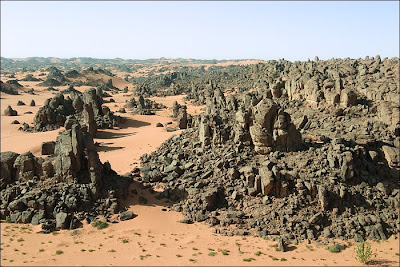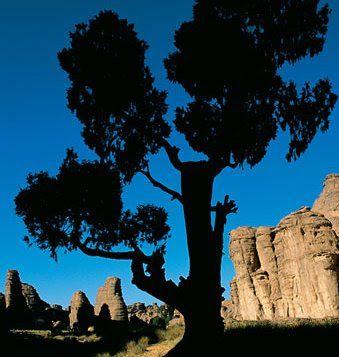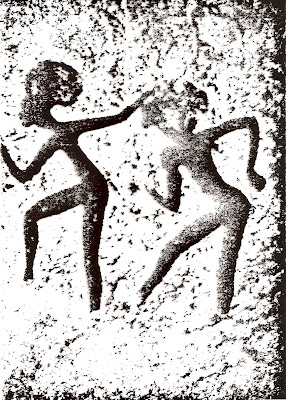
[Edward S. Curtis - Yurok Canoe on the Trinity River, 1923]
The Yurok, whose name means "downriver people," are Native Americans whose ancestors, by some estimates, have lived in the region for at least 10,000 years,

near the Pacific Ocean coast

of Northern California,

United States of

America.
***
The United States is situated mostly in central North America, where its 48 contiguous states and Washington, D.C., the capital district, lie between the Pacific and Atlantic Oceans, bordered by Canada to the north and Mexico to the south. The state of Alaska is in the northwest of the continent, with Canada to its east and Russia to the west across the Bering Strait, and the state of Hawaii is an archipelago in the mid-Pacific. The United States also possesses several territories, or insular areas, scattered around the Caribbean and Pacific.
At 3.79 million square miles (9.83 million km²) and with more than 300 million people, the United States is the third or fourth largest country by total area, and third largest by land area and by population.
***

[Northwestern California Native American Dance]
The Yurok Tribe is California’s largest Indian Tribe with nearly 5,000 enrolled members, and land including, but not limited to, the Yurok Reservation’s lands, which currently extend from one mile on each side from the mouth of the Klamath River and upriver for a distance of 44 miles. The Yurok Tribe’s people are also known historically as the Pohlik-la, Ner-er-er, Petch-ik-lah and Klamath River Indians. For millennia traditional Yurok religion and sovereignty was pervasive and practiced throughout all our historic villages along the Pacific Coast and inland on the Klamath River. The Yurok people carried on extensive trade and social relations through this region and beyond. Yurok commerce traditionally included a monetary system based on the use of dentalium shells, Terk-n-term and other items as currency.
Traditional ceremonies include the Deerskin Dance, Doctor Dance, Jump Dance, Brush Dance, Kick Dance, Flower Dance, Boat Dance, and others, that have drawn Yurok people and neighboring tribes together for renewal, healing and prayer.

California - Yurok - Women's Brush Dance

Brush Dance is a ceremony held to heal a sick child or to pray for a long, healthy life. The ceremony is somewhat of a social event where families and villages come together.

In the past, the dance would take place in a home of the child: the roof of the plank house would be removed.

Today however, dances take place at specific villages where dance pits still remain. More and more families are participating in dances, thus more dances are taking place throughout the summer. The medicine doctor, her helpers (medicine boy and girl), the child, and dance family begin the dance on a Wednesday. The medicine doctor begins the process much sooner. Actual dancing begins on Thursday night, with two dances. The medicine for the dance continues with dancing resuming Saturday night lasting until late Sunday morning and some say the dance ends before the sun rises above the hills. Other local tribes participate, making up different dance camps. Both females and males dance. Different tribes take turns hosting dance rounds.
***

[C Major Chinese Pentatonic Scale]
A pentatonic scale is a musical scale with five pitches per octave in contrast to an heptatonic (seven note) scale such as the major scale. Pentatonic scales are very common and are found all over the world, including but not limited to Native American music, Celtic folk music, Hungarian folk music, West African music, African-American spirituals, American blues music and rock music, Sami joik singing, children's songs, the clarinet music of Epirus in northwest Greece and Southern Albania, the tuning of the Ethiopian krar and the Indonesian gamelan, melodies of Japan and China (including the folk music of these countries), the Afro-Caribbean tradition, Polish highlanders from the Tatra Mountains, and Western Classical composers such as Claude Debussy, Maurice Ravel, Bela Bartok, Igor Stravinsky, and Mark Alburger.
***
The female soloist in Women's Brush Dance has a high, loud, intense tessitura (the part of her overall vocal range -- from low to high -- used in the piece) met by wild mumbles and shouts from her male call-and-response accompanists. The instruments are abalone-shell-disks sewn into the female dancers' costumes -- necessary for the performance. Text is a mixture of vocables and hidden words. The melody descends, in classic style, with a Chinese major pentatonic scale. Each phrase ends with an ascending a perfect fourth as Sol-Do, which is cross-culturally, worldwide, the most popular melodic start, and an oft conclusion, to melodies.
Texture is a memorable contrapuntal (note-against-note) accompaniment ostinato (repeated passage) starting softly, crescendoing, and eventually drowning out the soloist. The verse, or strophe, repeats three times, for the integrity of the song. Originally a healing piece, the song is done for entertainment and display. The reverence for the song and dance have not been lost. And what is it about the performance of the second verse that makes it "a good one?"...
***
Texture is the overall quality of sound of a piece, most often indicated by the number of voices (pitch lines) in the music and by the relationship between these voices. A piece's texture may be further described using terms such as "thick" and "light," "rough" or "smooth." For example, Aaron Copland's more popular pieces are described as having an "open" texture. The perceived texture of a piece can be affected by the number and character of parts playing at once, the timbre of the instruments or voices playing these parts and the harmony, tempo, and rhythms used.
In musicology, particularly in the fields of music history and music analysis, some common terms for different types of texture are:
Monophonic
One melodic voice without any other moving pitch line of accompaniment (although rhythmic accompaniment may be present), strictly performed
Heterophonic
One melodic voice without any other moving pitch line of accompaniment (although rhythmic accompaniment may be present), freely performed. A musical texture in which the voices are slightly different in character, perhaps moving in contrasting rhythms. The voices may play a single melody with simultaneous variations in that melody (an embellished/"ragged" form of monophony).
Homophonic
Multiple voices where one voice, the melody, stands out prominently and the other voices form a background of accompaniment. If all the parts have the same (or nearly the same) rhythm, then the homophonic texture can also be described as homorhythmic.
Polyphonic
Multiple melodic voices which are to some extent independent from one another.
Although in music instruction certain styles or repertoires of music are often identified with one of these descriptions (for example, Gregorian chant is described as monophonic, Bach Chorales are described as homophonic and fugues as polyphonic), many composers use more than one type of texture in the same piece of music.
***
The Women's Brush Dance can be notated in 4/4 time. The first three meaures of the melody could be sung as:
Sol Mi Mi Re Do Re
Mi Do Do La Sol La Sol Do
(N.B. the bold letters signify notes below, rather than above, Do)
***

In music notation, a tie is a curved line connecting the heads of two notes of the same pitch, indicating that they are to be played as a single note with a duration equal to the sum of the individual notes' note values.
The tie shown above connects a quarter note to a sixteenth note, creating a note 5/4 as long as a quarter note, or five times as a long as a sixteenth note -- there is no single note value to express this duration.
***

In Western musical notation, a dotted note is a note with a small dot written after it. The dot adds a half as much again to the basic note's duration. If the basic note lasts two beats, the corresponding dotted note lasts three beats.
Any note value may be dotted.
The use of a dot for augmentation of a note dates back at least to the 10th century, although the exact amount of augmentation is disputed.
More than one dot may be added; each dot adds half of the duration added by the previous dot, again, as shown above
A double-dotted note is a note with two small dots written after it. Its duration is 1¾ times (1 + ½ + ¼) its basic note value.
The double-dotted note is used less frequently than the dotted note. Typically, as in the example below, it is followed by a note whose duration is one-quarter the length of the basic note value, completing the next higher note value.
In a French overture (and sometimes other Baroque music), notes written as dotted notes are often interpreted to mean double-dotted notes, and the following note is commensurately shortened.

[An example of the use of double- and triple-dotted notes is the Prelude in G Major for piano, op. 28 No. 3, by Frédéric Chopin]
A triple-dotted note is a note with three dots written after it; its duration is 1⅞ times (1 + ½ + ¼ + ⅛) its basic note value. Use of a triple-dotted note value is not common in the Baroque and Classical periods, but quite common in the music of Richard Wagner and Anton Bruckner, especially in their brass parts.
***
In some cases one might tie two notes which could be written with a single note value, such as a quarter note tied to an eighth note (the same length as a dotted quarter). This might be because:
A barline is in between the notes
The second note begins a metric grouping, falling on a stressed beat of the meter. This change in notation (choosing the tie rather than the longer note value) does not affect performance, but it makes the music easier to read.
Several notes in succession can be tied together. Such a succession can also be part of a larger, slurred phrase, in which case, ties and slurs must be used simultaneously and distinguishably.
[2000 China Bone Flutes / 1998 Yurok California]





